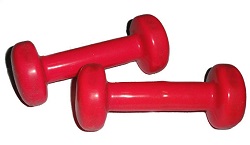
Jump unto the Resistance Exercise Bandwagon!

Resistance exercise involves lifting, pulling or pushing against a load with the aim of increasing strength, tone, mass, or muscular endurance. The load can come from dumbbells, exercise balls, weight machines, elastic bands, or even your own body weight. Progressive resistance is used to increase one's ability to exert or resist force. When your muscles work on weights greater than they are usually used to, they adapt by getting stronger and bigger. Common forms of resistance training include weight lifting, push-ups, doing squats, bicycling, rowing and swimming.
To get started, first establish a strength training routine and work it out consistently over time. Resistance training is usually combined with some form of aerobic exercise. It is done repeatedly in sets and each set can range from 8-15 repetitions. Start with light weights first and work up slowly. First work on your bigger muscles such as thighs, shoulders, buttocks, and chest as it helps you as it helps you gain leaner mass quicker. Working your bigger muscles will create a higher energy demand for them, and result in using more fat in store when you're not exercising. However, don't neglect your back, legs and shoulders.
Resistance training can raise metabolic rate and enable us to burn more calories with more muscle and help us lose or maintain our body weight. It will also improve our bone density and increase muscle strength and mass. Research has also proven that this form of workout has the health benefit of lowering blood pressure and lowering heart rate while at rest, and thereby reducing the risk of heart disease. The Hibernation Diet, which promises to help people lose weight while they sleep, advises that we should take our body back to its natural balance by taking wholesome food (including honey) and increasing the amount of fat we burn by doing resistance exercises. It's argued that this would stress the muscles and make the body repair them while we sleep by mobilizing stored fat in the body.